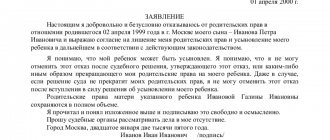Home » Paternity and Maternity » How to recognize paternity outside of marriage through the registry office
5
Many married couples live together for a long time without formalizing their relationship in any way. Children are often born into such families, and if everything is clear with the child’s mother, she is officially recognized as the baby’s mother upon the fact of his birth, then with the father it is not so simple. A man, in order to be considered a father by law, will need to go through the procedure of establishing paternity.
Establishing paternity
If a child is born in marriage, then the father of the born baby is a priori recognized as the mother’s husband. With children born out of wedlock registered with the registry office, everything is different. In this case, to establish family ties between the baby and his biological father, it will be necessary:
- voluntary recognition of the father by submitting an appropriate application to the registry office;
- establishment of paternity in court (recognition of paternity outside of marriage through the court).
In the first case, the establishment of family ties occurs either with the consent of the baby’s mother, or, in some cases, with the permission of the guardianship and trusteeship authorities.
If both common-law spouses wanted the birth of a baby and were ready to raise him together, then after the birth of the child they will have to visit the registry office and write a joint statement recognizing paternity. The procedure is quite simple and does not require much time. There, at the registry office, parents decide on the surname of the newborn.
In what cases is it possible to establish paternity in the registry office?
The main condition for the procedure for recognizing paternity outside of marriage through the registry office is voluntariness, on the part of both the father and the mother. That is, at the same time:
- a man who is the biological father of a child recognizes his son or daughter and voluntarily expresses a desire to formalize this fact legally:
- the mother agrees with this procedure and declares this in writing.
If one of the parents or both do not agree with this procedure, establishing paternity in the registry office becomes impossible. In this case, it will be possible to challenge the position of the mother or father only in court.
When establishing paternity in the registry office, it is necessary to keep in mind several more mandatory conditions:
- An application for recognition of paternity can be submitted by a citizen who is fully capable.
- Denial of paternity is subsequently impossible.
Important. If the citizen registered as the child’s father subsequently finds out that he is not the child’s biological father and proves that he did not know about this when he wrote an application recognizing the relationship between him and the child, the establishment of paternity can be challenged in court.
Grounds for challenging paternity
The basis for challenging paternity is, first of all, the record of the registry office about the father of the child, when in fact the indicated person is not the father of the child. In this case, a man can be indicated as the father of the child:
● due to the presence of a registered marriage with the child’s mother, while not being the child’s biological father;
● if the person, when establishing paternity, did not know that he was not the biological father of the child.
Evidence to challenge paternity
The law office "Katsailidi and Partners" provides evidence that the man is not the father of the child:
- explanations of the plaintiff and defendant, as well as third parties,
- witness statements,
- written evidence, such as letters, including email correspondence,
- photos,
- audio and video recordings,
- conclusion of a genetic examination, which is ordered by the court during the consideration of the case. The conclusion, of course, can be made by a man before going to court, but the child’s mother may question the reliability of the conclusion of the examination presented by the plaintiff. It is worth noting that genetic testing is the most important and most reliable evidence containing information about whether a man is the actual father of a child or not.
According to the position of the RF Armed Forces, if a child has reached 10 years of age, it is necessary to find out his opinion, since in this case the interests of the child are directly affected, and if the child’s mother recognizes the claim of the legal father, the court does not have the right to accept such recognition, because it entails a violation of the rights of the child. The court must evaluate evidence in its entirety.
Who can submit registration documents
An application to establish paternity can be submitted to the registry office by:
- The mother of the child, if she has a court decision recognizing the relationship between her baby and the defendant. This also includes cases of registration under the so-called “300-day rule,” namely: the baby’s father, being the legal spouse of his mother, died no earlier than 300 days before his birth;
- the spouses officially divorced, also no earlier than 300 days before the birth of the child.
- mother's death certificate;
In the presence of any force majeure circumstances, such as:
- threat to the mother's life during childbirth;
- serious illness of the father, if there is a possibility that he may not live to see the birth of his son or daughter;
- planned long-term absence of the child’s father (departure to another country, long business trip, etc.),
future parents can visit the registry office in advance and submit a joint application in which they will announce the first and last name of the unborn child and other necessary information. In this case, a birth certificate will also be issued after the baby is born.
What is needed to establish paternity at the registry office
According to ch. 10 IC RF and ch. 6 of Federal Law No. 143-FZ of November 15, 1997, citizens who have expressed a desire to recognize paternity voluntarily through the registry office must apply to this institution with an application to establish paternity, having with them the necessary documents, including a receipt for payment of the state fee (Article 333.33 of the Tax Code of the Russian Federation).
Civil Registry Office employee:
- will check the correctness of filling out the document and, if necessary, help draw it up;
- will check the availability of documents attached to the application;
- fill out the child’s birth certificate and hand it over to the parents;
- will make the appropriate registration entry in the civil status acts.
In accordance with the legislative acts listed above, there are several options for citizens to apply for voluntary recognition of paternity:
- Together the mother and father of the baby.
- One father, if there is permission from the guardianship and trusteeship authorities.
- The father of an adult child with the latter’s consent to the procedure.
At the same time, the law establishes several mandatory requirements for the father who applies to the registry office:
- His decision must be voluntary.
- Full legal capacity of the father.
- Personal presence. In this case, filing an application through a legal representative is not allowed.
- The father must clearly understand that subsequently he will not be able to abandon his family connection with the child.
If another citizen is already entered as the father on the birth certificate, recognition of paternity by the civil registry office is impossible. But there are some exceptions here:
- if paternity was subsequently successfully challenged in court;
- if information about the father is entered according to the words and wishes of the mother,
then, upon voluntary recognition of paternity by a man not included in the “father” column, the entry in the birth certificate and civil status acts is corrected.
Voluntarily
The birth of a child without official registration of marriage is not uncommon in modern society.
And the first document that children receive is a birth certificate, which displays information about their parents. There can be no problems with indicating the mother’s personal information, since her biological relationship is beyond doubt. But the column of the second parent often remains missing. The father's consent to provide personal data is an automatic consent to paternity. But there are cases when both parents cannot appear at the same time to receive the baby’s birth document, which does not allow entering information about the father. In this case, the common-law spouses may arrive later in order to make changes to the contents of the certificate. The man writes a statement indicating recognition of the paternity of an illegitimate child, and the information is entered into a unified register.
Rules and procedures
Like any other legally significant procedure, the establishment of paternity outside of marriage in the registry office must be carried out in a certain order and according to certain rules stipulated in legislative acts. Let's take a closer look at the most common options for acknowledging paternity through the registry office.
Option 1. Joint application by both parents
The most common option. In this case, establishing paternity in the registry office is possible only on a voluntary basis. If the father or mother of the child has not expressed a voluntary desire to establish a relationship between the baby and his father, the problem can only be resolved in court.
Important. As soon as a birth certificate is received, in which the name of the biological father will appear in the “father” column, the man acquires all paternal rights and responsibilities in relation to the baby, including the obligation to support his son or daughter and, accordingly, if necessary, payment of alimony.
There are no time restrictions for filing an application for recognition of paternity at the Civil Registry Office. It can be submitted:
- During the mother’s pregnancy, that is, even before the baby is born . The condition under which the application will be accepted by the registry office staff before the birth of the child is the following: the mother or father assumes (and there are quite good reasons for this) that their joint application after childbirth is impossible. Confirmation of pregnancy with a certificate from a medical institution is required.
- During registration of the baby's birth . Birth registration is carried out at the request of one of the parents; if a child is born outside of an official marriage, at the request of the mother. The basis for registering a birth is a certificate from the maternity ward stating that the citizen gave birth to a child on the ___ day of ___ month ___ year. It is at the moment of registering the birth of the baby that his parents can jointly visit the registry office and write a statement in which they will petition for recognition of the family connection of the newborn with his father.
- At any other time convenient for parents . The law does not limit in any way the period of joint voluntary application by parents for recognition of paternity.
Procedure for establishing paternity
The algorithm of steps in the voluntary recognition procedure is as follows:
- Drawing up an application for recognition of family ties . The law does not stipulate in any way what form the application should be in - written or printed. Civil registry office employees can submit a ready-made application form for completion, where you only need to fill in the blank lines and columns.
- Collection of necessary documents . The list of documentation that will be needed in this case is presented below.
- Visit to the Civil Registry Office . You must contact the registry office department that is located at the place of registration of one of the child’s parents, usually this is the place of registration of the mother.
- Obtaining a document establishing paternity . This usually happens on the day of application, or the next day if the married couple applied to the registry office at the end of the working day.
- Obtaining a new child's birth certificate.
Application for establishing the fact of recognition of paternity (sample)
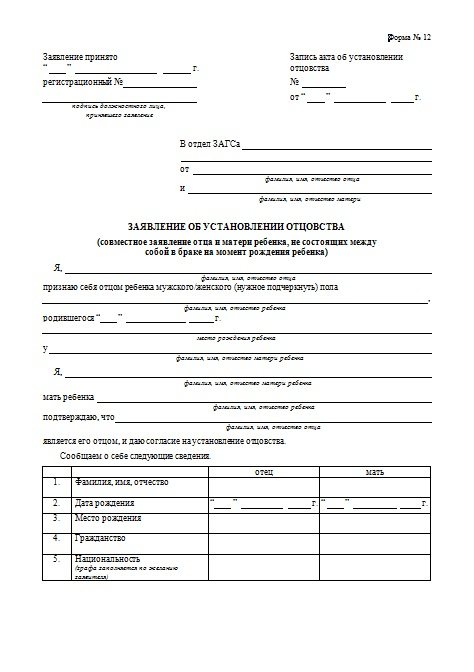
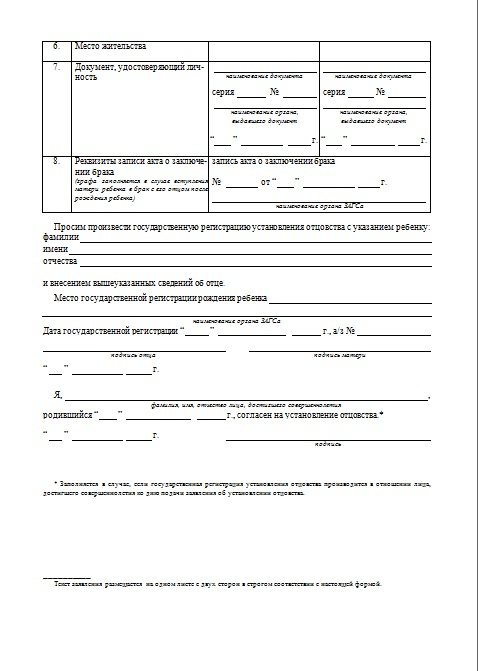
Sample of a joint application from mother and father for recognition of paternity through the registry office
The document has a standard form and is drawn up jointly by the child’s parents. The following items are required to be completed:
- The name of the registry office department where parents apply.
- Last names, first names and patronymics of the baby's mother and father.
- The item in which is written: father's full name;
- Baby's full name;
- gender, date and place of birth of the son or daughter;
- the will of the applicant to recognize the child.
- their dates of birth;
What documents will be needed
Before listing the required documents, it must be said that all of them must be submitted in originals; photocopies, scanned copies and other non-original documents will not be accepted. So, you will need:
- Passports of both parents.
- If the baby’s birth certificate has not yet been received, then a certificate from the maternity hospital.
- Baby's birth certificate. If the child is already 14 years old, then his passport.
- The child’s written consent to change his last name (if he is already ten years old).
- Receipt for payment of state duty.
During the procedure for acknowledging paternity at the registry office, parents can change the child’s surname to the father’s. It must be remembered that if he has reached the age of ten, then his written consent to change his surname is required. The child's middle name changes without fail depending on what name the biological father has.
Option 2. Father’s appeal on his own
To apply to the registry office for recognition of paternity, it is not always possible to obtain the mother’s consent to carry out the procedure. For such situations, legislative acts allow the child’s father to independently apply, but with the obligatory consent of the guardianship and trusteeship authorities.
The second parent has the right to apply to the registry office for recognition of paternity in cases where the child’s mother:
- is wanted, that is, her whereabouts are unknown;
- declared missing by the court;
- deprived of parental rights;
- declared incompetent by the court;
- died.
Naturally, in the situations described above, it is not possible to obtain the mother’s consent, but the child should not suffer in any case. Therefore, the law provides for the consent of the guardianship and trusteeship authorities to carry out the procedure for establishing the relationship between the baby and his father, so that the child has at least one parent.
Refusal to carry out the procedure on the part of the PLO occurs in very rare cases, for example, if the child’s father is released from prison, where he served a sentence under a “severe” article, or he is registered in a drug treatment clinic, or is also declared incompetent. In all other cases, guardianship willingly accommodates the baby’s father, as this corresponds to the legitimate interests of the baby.
Obtaining guardianship consent
In order to obtain permission from the Public Prosecution Service to recognize paternity at the registry office, the second parent must contact the Department of Public Promotion, which is located at the place of registration of the minor. He must have with him:
- passport;
- the child’s birth certificate, or, if he has already reached the age of 14 years, then his passport;
- consent of the child (upon reaching the age of ten);
- a document confirming the absence of the mother;
- application for permission to carry out the procedure.
Due to the fact that issues of guardianship and conservatorship in Russia are transferred to the jurisdiction of the constituent entities of the Russian Federation, the procedure for issuing such permits in different regions may differ slightly. PLO employees may additionally ask the father to provide:
- an extract from the house register;
- certificate of no criminal record;
- medical certificate about the health status of the alleged father;
- a certificate in form 2-NDFL to confirm the financial viability of the parent;
- characteristics from your place of work or place of residence.
The period for consideration of the application is 15–30 days from the date of application. But, as a rule, PLOs try not to delay the issuance of permission, since it is in the interests of the child to identify at least the father as soon as possible, if he does not have a mother.
Documents in the registry office
When applying to the registry office, the applicant must have with him:
- passport or a document replacing it;
- statement;
- consent of the PIO to carry out the procedure;
- the child’s consent to recognition of paternity (upon reaching the age of ten years);
- birth certificate or passport of a minor;
- documents from which it follows that the mother is absent;
- receipt for payment of state duty.
To confirm the mother’s inability to attend the paternity recognition procedure, it is necessary to submit one of the following documents:
- a court decision declaring the baby’s mother incompetent that has entered into force;
- a court decision to deprive her of parental rights;
- a certificate from the police department stating that she is wanted;
- a court decision declaring the mother missing;
- death certificate.
Statement from the father to establish the fact of recognition of paternity (sample)
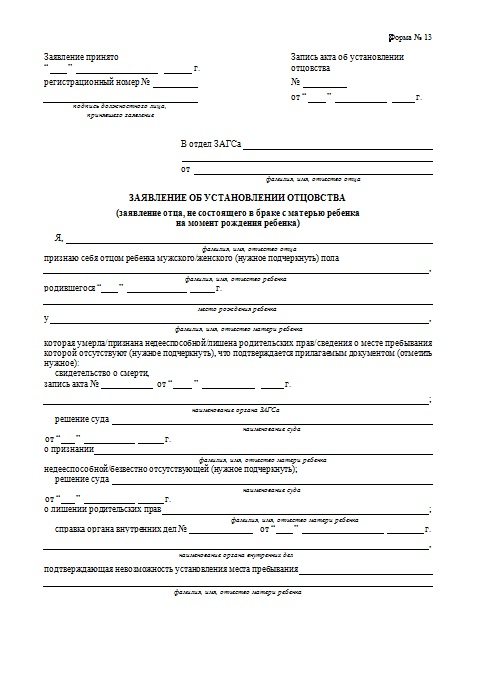
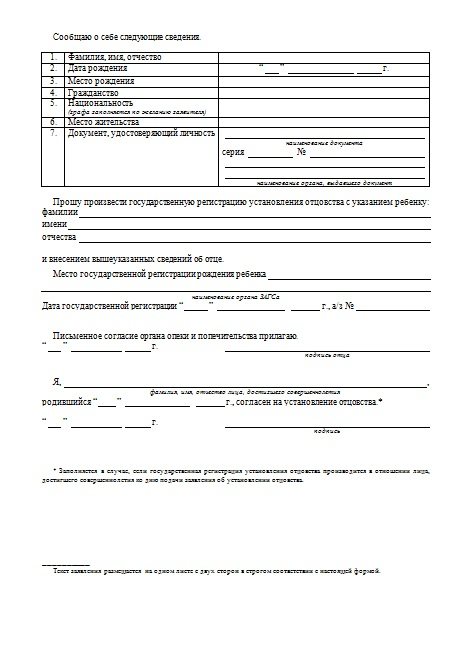
Sample father's paternity statement
Option 3. Appeal from the father of an adult child
In this case, the procedure for recognizing paternity is practically no different from those described above. But in any case, the registry office will require the potential father to provide written consent from his son or daughter to the procedure. Additionally, the personal presence of an adult child will be required.
In cases where the son or daughter is already an adult but recognized as incompetent, instead of the consent of the child, the sanction of his guardian will be required; accordingly, the guardian, and not the son or daughter deprived of legal capacity, will have to be present during the procedure for recognizing paternity.
Challenging paternity in court
Requests to change the record of the child’s father by entering relevant data are possible only by court decision. To do this, it is necessary to initiate legal proceedings in this case. The legislator did not provide any other ways to challenge paternity.
Challenging paternity is a complex legal procedure that requires a lot of time and nerves. It is extremely important to collect the maximum amount of evidence on the basis of which the court will make a positive decision.
According to Article 55 of the Code of Civil Procedure of the Russian Federation, evidence includes: explanations of the parties, third parties, testimony of witnesses, written evidence, audio and video recordings, expert opinions. Depending on the situation, taking into account the above, it is necessary to collect evidence to challenge paternity. From our practice, we see that the most suitable evidence in these trials is the result of genetic testing.
After obtaining the necessary evidence, a statement of claim should be drawn up to challenge paternity, which presents demands based on the collected evidence with reference to the current provisions of the law.
A genetic examination is ordered by the court if a request for this is received from the participants in the process; the court does not order a genetic examination on its own initiative. When filing a claim to challenge paternity, the plaintiff may ask the court to conduct an appropriate examination.
After collecting evidence and drawing up a claim, it is necessary to send the entire package of documents to the district court according to the number of participants in the process and for the court itself. Most often, the participants in the process of challenging paternity are the registered father of the child, the actual father, sometimes the guardianship and trusteeship authorities, and representatives of the registry office.
Documents can be sent to the court by transferring them through the court office (in this case, we recommend making a copy of the claim for yourself, on which you should ask the office employee to mark “incoming” and sign), or sending the documents by mail (in this case, it is necessary to make an inventory of the attachment and notification of delivery).
After receiving the documents, the court makes one of the following rulings:
- on acceptance of the claim for proceedings. This determination is accepted by the court if the claim satisfies all the legal requirements for its content;
- about leaving the claim without progress. This determination is made if the claim contains a defect and the court proposes to eliminate it within the allotted time;
- about the return of the statement of claim. The said determination is made by the court, for example, if the case is beyond the jurisdiction of this court.
If a ruling is made to accept a claim challenging paternity for proceedings, the court sends copies of the ruling to the participants in the process indicating the time of the first court hearing.
After receiving the appropriate determination, we recommend that the defendant in the case write a response to the statement of claim, in which he indicates the reasons for disagreement with the claim and provides relevant evidence. The defendant’s presentation of his position orally during court hearings is often ineffective because it is reflected in the court record in a distorted form or is not entered there at all.
At the appointed time, the first court hearing takes place, during which the parties state their position on the essence of the case, present arguments and counter-arguments, citing relevant evidence.
During the process, the parties need to petition the court to collect evidence that they could not obtain themselves, including a genetic examination.
Based on the results of the consideration of the case, the court makes a decision to satisfy the claims or to reject the claim. The court decision can be challenged within a month from the date of its adoption. After a month, unless one of the parties appeals, the court decision enters into legal force.
Genetic examination in a case of challenging paternity
Genetic examination in a case of challenging paternity plays a leading role among the evidence. The plaintiff should apply for it when filing a claim or during the process; the defendant must indicate its implementation in the response to the claim or also during court hearings.
In the application for genetic examination, it is necessary to indicate the expert institution in which the applicant requests to conduct the examination.
If one of the parties submits a request to conduct a genetic examination, the court makes a decision to grant the request or refuse to satisfy it, which happens extremely rarely and only if all the evidence available in the case indicates that its conduct is pointless.
During the genetic examination, like any examination, according to Article 216 of the Code of Civil Procedure of the Russian Federation, the court has the right to suspend the proceedings, which it most often does. The court’s performance of this action is primarily due to the fact that the two-month period established by law for consideration of a case challenging paternity is very short, since such cases are usually complex and, in order not to violate the allotted period, the court suspends the proceedings in the case.
The court cannot oblige the parties to come to the appropriate institution to conduct a genetic examination, but if a party refuses to conduct it, the court will consider that the refusal confirms the arguments of the counterparty in the case.
Initially, the cost of conducting a genetic examination is paid by the party applying for it; if it wins the case, the court will recover payment from the losing party to the expert institution.
Challenging paternity in court at the request of the mother
The child's mother can initiate a paternity challenge if she finds out that the child's father is another man.
During the trial, she is not required to prove that she did not have information about the child’s biological father at the time of his birth. The court needs to establish the fact of relationship between the biological father and the child, and not the reason for hiding the truth.
The participation of the child’s mother in a trial to challenge paternity is an extremely difficult situation, not only from a legal, but also from a psychological point of view, since in court, most often, both the registered father of the child and the man claiming his role are present, and both try to humiliate the woman in every possible way , insulting her. If there is reason to believe that the process will follow this path, we recommend that the child’s mother send her authorized representative to the process.
Challenging paternity in court at the request of the father
Challenging paternity in court is allowed upon the application of the biological father of the child or a man who considers himself such.
Since there is no statute of limitations for challenging paternity, you can file a claim at any time, but you must remember that if the child reaches the age of majority, it is necessary to obtain his consent to the trial. Filing a claim does not depend on the time when the man found out that he was the father of the child or began to suspect it.
Legal consequences of challenging paternity
If the court satisfies the claim to challenge paternity, the entry in the registry office about the child’s former father is removed and a new entry is made about the actual father of the baby. The registered father of the child is recognized as a full-fledged parent with all the ensuing rights and responsibilities in relation to the child: the right to education (at the same time and obligation), the obligation to support, including the payment of alimony, the right to inheritance (both the child’s father and the father for the child), etc.
In case of refusal to satisfy the claims, the plaintiff will not be able to re-file a claim against the defendant to establish paternity, in accordance with clause 2, part 1, article 134 of the Code of Civil Procedure of the Russian Federation. In addition, the losing party will have to pay legal costs to the winning party.
Challenging paternity in Kazan
If you need to challenge paternity in Kazan, our lawyers are always at your service. Extensive experience in handling family disputes will allow us to achieve results in the shortest possible time and without nerves.
Consequences of the procedure
From the moment the father is included in the baby’s birth certificate and the document is handed over to him, he acquires all the rights and responsibilities of a parent in relation to the baby. In turn, the child receives the right to:
- receiving alimony;
- inheritance;
- bearing the father's surname;
- living with dad;
- communication with him.
Also, in the event of the death of the father, the minor receives the right to receive a survivor's pension.
The rights and responsibilities of father and child are mutual. For example, a man, in turn, if necessary, has the right to recover financial support from an adult capable child, but only in those cases provided for by Russian legislation.
So, we found out that recognizing paternity outside of marriage through the registry office is a fairly simple procedure. However, the potential father must remember that if he recognizes the child voluntarily, then he will not be able to refuse his paternal responsibilities in the future. That is why, before embarking on the procedure for voluntary recognition of paternity, it is necessary to carefully weigh all the pros and cons of acknowledging paternity.
You can get more complete information about the procedure, its pros and cons, by contacting a specialist on our website. You can do this in two ways:
- call the indicated numbers;
- write a message online.
FREE CONSULTATIONS are available for you! If you want to solve exactly your problem, then
:
- describe your situation to a lawyer in an online chat;
- write a question in the form below;
- call Moscow and Moscow region
- call St. Petersburg and region
Save or share the link on social networks
(
1 ratings, average: 1.00 out of 5)
- FREE for a lawyer!
Write your question, our lawyer will prepare an answer for FREE and call you back in 5 minutes.
By submitting data you agree to the Consent to PD processing, PD Processing Policy and User Agreement
Useful information on the topic

Restoration of paternity after deprivation of parental rights
Any mother or father immediately after registering the birth of the baby...

Statement of claim for deprivation of paternity
Deprivation of parental rights is one of the most difficult, especially in...

1
How to register paternity for a child in a civil marriage
If a baby is born to parents who live in a civil marriage,...

2
How to establish paternity without mother's consent
There are often situations when the child’s father does not want to participate in his...

Certificate of paternity
The blood relationship between mother and child does not require additional...

Establishing paternity in court: step-by-step instructions
The birth of a baby is one of the most long-awaited events in almost...








